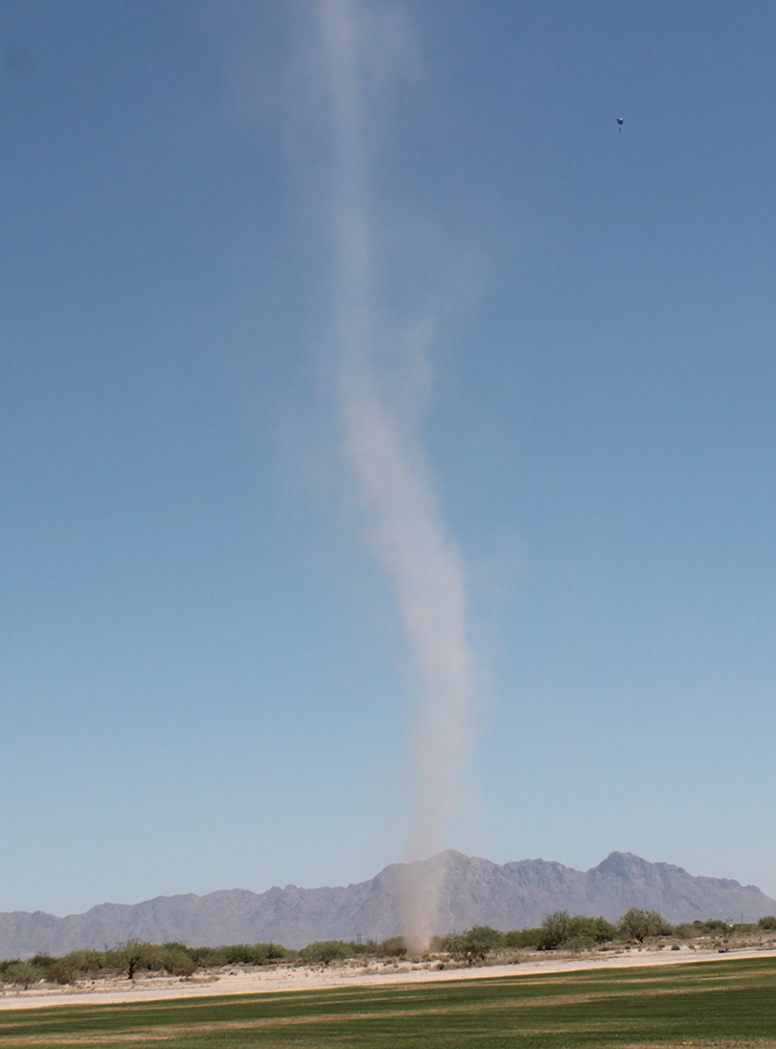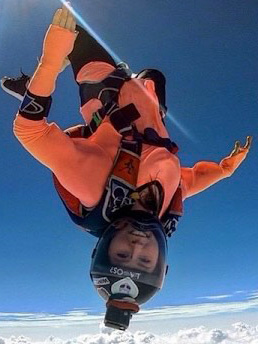Skydiving in the Heat
Above: Photo by Mike McGowan.
This article appeared in its original form in a blog post on the skydiving website augustobartelle.com.
Summer is here, and it’s the prime skydiving season for many drop zones around the world. But summer also means temperatures well over 100 degrees Fahrenheit at some drop zones, and the effects of the heat may be so serious that some choose to operate only during the cooler morning hours. Most skydivers love the long, hot days, but problems with canopy flight, aircraft performance and skydiver health come along with the sunshine. So, take extra precautions when skydiving in extreme heat and educate yourself on how the hot weather affects your canopy’s flight characteristics so you can fly safely all season long.
Density Altitude
Density altitude is pressure altitude corrected for nonstandard temperature. In a sense, it’s the altitude at which an airplane or your canopy “feels like” it is flying. As temperatures increase, air density decreases. In simple terms, when it’s hot, the air will be thinner, as if your altitude were a few hundred to a few thousand feet higher than it actually is. (For a more in-depth look at density altitude, see “High and Fast: Understanding Density Altitude” by Megan Walker-Radtke, March 2014 Parachutist, available under the Back Issues tab at parachutist.com.)
 Photo by Kevin Mitchell.
Photo by Kevin Mitchell.In practice, this means that your canopy will have a faster forward speed and faster descent rate on a hot day than it would on a cooler day. Your canopy will lose more altitude in a turn, so be aware of this if you are thinking of performing any aggressive maneuvers. Your canopy will open with more force and have a higher stall speed, and you’ll also notice that your flare has less power. Your canopy will quite literally be “coming in hot.”
This also means that the middle of a summer heat wave is no time to demo a smaller, faster canopy, because it will feel like an even smaller, even faster canopy. If you’ve been thinking about downsizing or switching to a more aggressive canopy, it’s wise to wait for cooler weather.
High density-altitude is one of the reasons why some drop zones close down or operate only in the morning hours. Extreme heat causes performance to degrade, and aircraft need longer runways for takeoffs and landings. The climb to altitude will be slower and flatter, the plane will use more fuel and chances are the skydivers on board will be hot and miserable during the long climb to altitude. A high density-altitude reduces propeller effectiveness and piston and turbine performance. This effect isn’t limited to jump planes, either. Even the big Airbuses and Boeings can be grounded due to extreme heat (although the threshold is higher).
Turbulent Thermals
If you’ve jumped at a hot-weather drop zone, you’ve certainly heard about thermals—localized, vertical air movements that develop when the ground is significantly warmer than the air above—and the associated turbulence they cause. Thermals are common in the summer, but it’s very hard to predict exactly when they’ll occur because conditions can change by the hour. However, you can count on these hot-weather hazards developing when solar heating of the ground is strongest, generally 10 a.m. to 5 p.m.
Turbulent thermals are most likely to develop over surfaces that radiate a large amount heat—rocks, sand, tarmac, etc.—as the warm air rises and then cools to the temperature of the air above. Thermals can be as wide as a few thousand feet, and have a vertical speed of a few hundred to a few thousand feet per minute. And for every rising thermal current there is a compensating descending air flow.
These convective currents cause bumpy, turbulent conditions near the ground, which can cause a very bumpy approach to landing. Updrafts induce lift in your canopy, which may result in your overshooting your landing, while downdrafts feel like the air suddenly drops out from beneath your canopy, causing hard landings and undershooting. Skydiving in the heat and encountering turbulence go hand in hand, so be sure to talk to your Safety and Training Advisor to learn about turbulence at your DZ.
Dust Devils
Thermal turbulence can produce dust devils—vertical thermal columns, sort-of localized mini-tornados—which are extremely dangerous and life threatening to skydivers under canopy. They usually form over heat-radiating surfaces when the weather is extremely hot, the winds are light and the skies are clear and blue. They are especially frequent and intense in areas where surfaces with different thermal characteristics are in close proximity to each other (think a sandy landing area next to an asphalt road).
Once a dust devil forms, it is difficult to predict where it will travel. It will move with the speed and direction of the surrounding wind within the layer that it occupies. This means that a dust devil may suddenly change direction once it reaches a certain altitude, often resulting in the appearance that it is leaning. Although dust devils can reach a few thousand feet in height, they are usually about 100- to 300-feet tall. They usually last for four minutes or fewer, but can reach speeds up to 34 mph. Sometimes they pick up debris like sand, which make them easier to see, but they can often be nearly invisible.
Flying your canopy through a dust devil can be deadly or lead to severe injury. It may collapse your canopy close to the ground and send you plummeting to the earth, or it may whip your canopy around without notice. If you see a dust devil on the ground, attempt to fly your canopy crosswind to avoid it. Of course, you must react with caution to avoid a low turn or canopy collision. If you do fly into a dust devil, keep your canopy in full flight for maximum pressurization, use minimal inputs and prepare to make a parachute landing fall.
The best way to avoid flying your canopy into a dust devil is to maintain awareness of weather conditions. If dust devils are observed near the landing area, consider not jumping until the weather cools. It is a better idea to stay on the ground and jump in more predictable weather conditions.

Photo by Brian Binder.
Protect Your Gear
Did you know that skydiving gear needs to be protected from the sun? UV damage can rapidly reduce the strength of you canopy fabric, making it easier to tear. The sun can also quickly fade the beautiful colors of your container and canopy. Help maintain your canopy and skydiving container this summer by following these steps:
Limit UV exposure. Canopies are mostly nylon, and nylon is extremely susceptible to UV damage. About 70-80% of an average canopy’s degradation over time is a result of UV exposure. So, when you land your canopy in the summer sunshine, quickly gather it up and head to a covered packing area. If you are not packing immediately, keep your canopy out of direct sunlight while it is waiting.
Cover your rig if it is sitting in direct sunlight. This is important both while you are packing and especially if your rig is sitting waiting to be packed. It is very easy to bring a beach towel along with you to the drop zone so you can cover your rig.
Watch out for sweat! Salty sweat can deteriorate your canopy rapidly and increase its susceptibility to damage from UV rays. Wear a dry shirt while packing your canopy, especially before you lay on top of it to get the air out. And if you give it to a packer, maybe try to choose one whom looks a little less sweaty!
Protect Yourself
Now that you know how to protect your gear in the summer heat, you must also remember to protect yourself! Jumping on multiple loads in the heat of the summer can leave you dehydrated really quickly. It won’t take long, so remember to drink water as often as possible. No one wants to get sick from sun exposure when they can be enjoying summer skydiving!
Just like your canopy, your skin does not fare well with extreme amounts of UV ray exposure. Be sure to cover yourself from the sun with a hat, stay in the shade and wear sunscreen! It is no fun trying to put a rig on sunburned skin. This summer, burn only your jump tickets!
Whether you are a veteran skydiver or a newbie, remind yourself of heat hazards each summer season. This also goes when you take a skydiving vacation to somewhere warm. Inform yourself about the conditions you are jumping in, always!
 About the Author
About the Author
Cori Sirois, USPA #303828, is also a member of the Canadian Sport Parachuting Association. She began jumping in 2015, and calls SkyDance SkyDiving in Davis, California, her home DZ, although she has been living in Europe for the past few years. She is currently a tunnel instructor at Flyspot Katowice in Poland and is enjoying the European flying community.